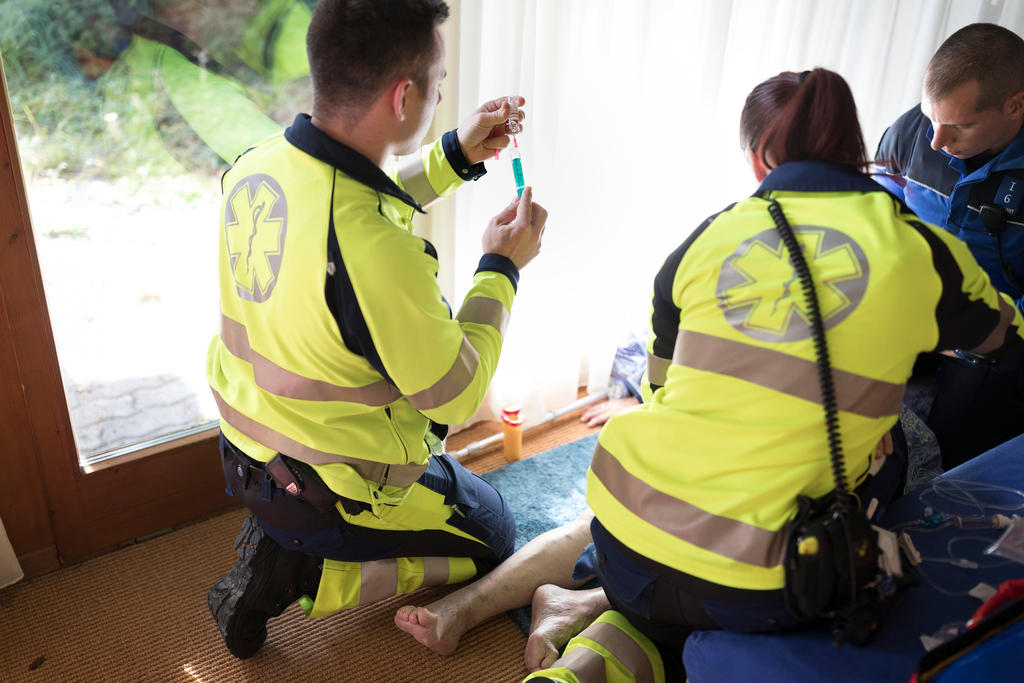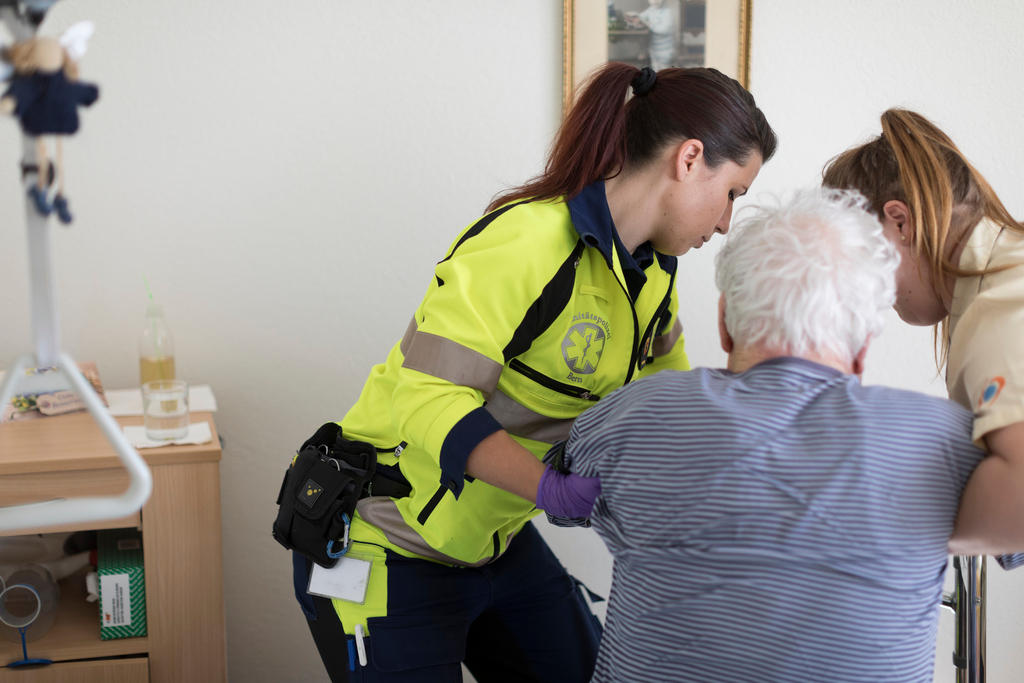In Switzerland, who should foot the bill for pricey ambulance rides?

Swiss patients pay for most emergency transport out of pocket, and costs can add up. Rescue professionals are now seeking changes so their life-saving interventions can be billed to basic health insurance.
Georges Vittoz remembers well a time in the 1990s when an ambulance ride would cost a patient CHF200 ($208). Nowadays, a bill for medical transport can total several times that amount, much of it paid out of pocket. Some patients resort to paying their ambulance bills in monthly instalments. Others forgo the service completely.
Vittoz, who used to head pre-hospital emergency services for the French-speaking canton of Vaud, gives the example of housebound patients with chronic conditions who need regular medical transfers.
“The first bill is covered 50% by basic health insurance, but if they don’t have a complementary health package, then the next bills often fall completely on their shoulders,” he says. “So they stop calling the 144 [emergency number].”
For amateur diver Alfred Suter, who was rushed to hospital following a lake dive in canton St. Gallen, the ambulance bill came out to more than CHF2,400 ($2,490), or half of his monthly salary, as he told Swiss German-language televisionExternal link. Suter is making the payments in instalments.
Depending on the canton, a single ambulance ride with an attending physician costs on average between CHF850 and CHF1,900, according to a 2014 study. Basic health insurance reimburses half of the cost of an ambulance ride, but only up to CHF500 in a year, as the law does not place transport and rescue on a par with ambulatory services like doctor’s visits. Patients are left to foot the rest of the bill, which can quickly add up if they require multiple ambulance rides over the course of a year. Meanwhile, air rescue in the Alps can cost as little as CHF30 per year (see box).
“[Ambulance transport] is one of the only sectors of the Swiss health care system where there is a strong barrier to access to care,” says Vittoz. “We save lives, but the law does not recognise our work as such.”
He and his colleagues at the umbrella organisation for rescue services are now calling for changes to 20-year-old legal provisions that they say have not kept up with developments in first-response interventions – or inflation.
Mountain rescue operations
When a hiking tour in the Alps goes wrong and search and rescue operators are called, a Swiss resident can expect the same coverage from basic health insurance for an airlift as for ground transportation – a paltry CHF500 for the year or up to CHF5,000 for an emergency rescue where the person’s life is in danger. But mountain rescue can be a very costly affair indeed, which is why around 3.2 million people are donors to Swiss air rescue service RegaExternal link. For as little as a CHF30 donation for a single person per year, Swiss Alpine Rescue will forfeit fees not covered by health or accident insurance incurred in an emergency rescue.
With Rega services called on every 33 minutes on average in 2017, rescue in mountainous or isolated areas is hardly a rare occurrence. Luckily visitors to Switzerland hoping to do some alpine walking or skiing are also entitled to make a donationExternal link to Rega and receive coverage for any rescue within the country’s borders.
A law divorced from reality
Carlo Casso is part of the committee leading the Interassociation Suisse de sauvetageExternal link, the Swiss association for rescue services. He traces the problem back to legislation on basic health insurance written over two decades ago. At the time, ambulance transfers were seen merely as a transport service, subject to minimal insurance coverage, rather than a medical necessity, in which case costs are borne primarily by mandatory basic health insurance.
But Casso says the situation has changed significantly, starting with the professionalisation of the service. Ambulance attendants must now complete 5,800 hours of training and are equipped to offer patients what amounts to pre-hospital care. They’re also bound to respond to 90% of cases within 15 minutes.
“They work in emergency situations where quality and speed are critical to keep people alive or reanimate them,” says Casso.
“Yet ambulance attendants are not considered as health professionals.”
Another development has been the creation of a centralised emergency number (144) that ensures proper screening by trained staff so ambulances are dispatched only if deemed necessary.
But patients have noticed the biggest changes in their pocketbooks. The cap of CHF500 for reimbursement of medical transport (or CHF5,000 for an emergency rescue) was set in 1995, a figure that bears little resemblance to what it costs today.
“The current legal provisions are completely obsolete,” Georges Vittoz says. “This means that, when you interpret the law, it’s the insurance companies that have the advantage.”

More
Health and emergencies
Vittoz and Casso acknowledge that having a quality first-response system that’s ready to be dispatched quickly any time of day or night costs money. But they don’t believe patients should have to shoulder most of the financial burden.
“The cantons and communes should cover the operational costs of having this safety service in place, just as they do for the police or fire brigade,” says Casso. “Patients should only have to pay costs generated during an intervention.”
Relief in sight?
Calls for change have grown more vocal since the Swiss price watchdog revealed in a 2014 analysis just how high and disparate medical transport costs are across the country. In response, the Federal Office for Public Health says it has held several meetings with health care professionals and insurance companies to discuss possible new measures.
“One issue in particular is how we can go about collecting data on costs and services, so we can do a proper evaluation of the contributions [by patients and basic health insurance],” says Grégoire Gogniat, a spokesperson for the public health office.
It’s a task complicated by Switzerland’s federalist system. Cantons are currently free to decide how to structure emergency transportation and the fees that go with it, so different fee models dictate the final costs for patients across Switzerland. Pre-booked ambulances can be three times more expensive in some parts of the country, the 2014 report showed. Many believe this disparity has to end.

More
Meet the man trying to make Switzerland less expensive
“We should have a uniform system for the calculation of fees for the whole country, so that the price doesn’t depend on where you live,” says Stefan Meierhans, the country’s price watchdog.
Having a single fee model would help with transparency and ensure fees are calculated the same way. Both rescue services and insurance groups agree it’s a desirable solution but they remain divided on other measures.
The rescue services association is lobbying for legal changes so that medical transport and use of rescue personnel are treated similarly to ambulatory services, and most of the costs are covered by basic health insurance rather than the patient. It recently presented federal authorities with a concrete proposal for changing the law.
The health insurers’ umbrella organisation santésuisseExternal link, however, is focused on prices. It wants to see the same types of services being billed by medical transport suppliers across the country based on fees that are closer to the national average.
“Doing something about the price of the service itself seems to us to be more efficient than transferring coverage of costs from the patient to the insurance company, because the latter would have an impact on premiums,” says santésuisse spokesperson Christophe Kaempf.
For his part, the price watchdog has approached cantonal authorities and unions with his recommendation of a single fee calculation system. Meierhans is optimistic relief will eventually be at hand for patients.
“I hope that by the end of this decade, by 2020 at least, we’ll be a step further,” he says.
“But everything in Switzerland takes time.”
96 – Total emergency rescue services in operation
2,500 – Total ambulance personnel
1,200 – Average number of times emergency services intervene in a day
70 – Percentage of interventions that involve a health emergency
80 – Average length of an intervention by emergency services, in minutes
33 – Average mileage for an intervention, in kilometres
50 – Percentage of emergency services clients aged over 65
20 – Percentage of Swiss population aged over 65
Source: Swiss Health ObservatoryExternal link, 2016

In compliance with the JTI standards
More: SWI swissinfo.ch certified by the Journalism Trust Initiative





You can find an overview of ongoing debates with our journalists here . Please join us!
If you want to start a conversation about a topic raised in this article or want to report factual errors, email us at english@swissinfo.ch.